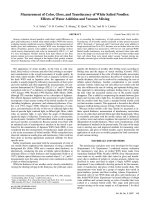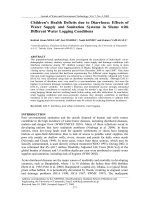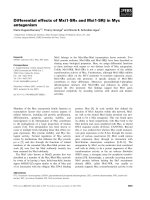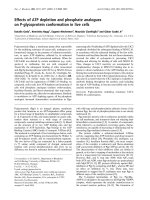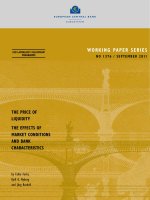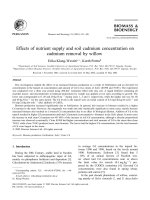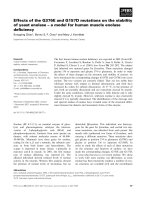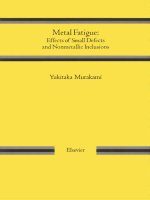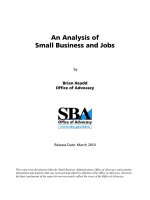Metal Fatigue:Effects of Small Defects and Nonmetallic potx
Bạn đang xem bản rút gọn của tài liệu. Xem và tải ngay bản đầy đủ của tài liệu tại đây (10.66 MB, 390 trang )
Metal
Fatigue:
Effects of Small
Defects
and
Nonmetallic Inclusions
Yukitaka Murakami
Elsevier
Metal Fatigue:
Effects of
Small
Defects
and Nonmetallic Inclusions
Elsevier Science Internet Homepage
-
Consult the Elsevier homepage for full catalogue information
on
all books, journals and electronic products and
services.
Elsevier Titles
of
Related
Interest
CARPINTERI RAVICHANDRAN
ETAL
Minimum Reinforcement in Concrete Mernhers.
ISBN:
008-043022-8
Applications.
FUENTES
ETAL
Fracture Mechanics: Applications and Challenges.
Small Fatigue Cracks: Mechanics, Mechanisms
&
ISBN:
008-04301 1-2
R6MY
&
PETIT
ISBN:
008-043699-4
JONES
Failure Analysis Case Studies
11.
ISBN:
008-043959-4
KISHl
ETAL.
Acoustic Emission. Beyond the Millennium.
ISBN:
008-043851-2
MACHA
ETAL.
Multiaxial Fatigue
and
Fracture.
ISBN:
008-043336-7
MARQUIS
&
SOLIN
Fatigue Design of Components.
ISBN:
008-043318-Y
MARQUIS
&
SOLIN
Fatigue Design and Reliability.
ISBN:
008-043329-4
Temperature-Fatigue lntcraction.
ISBN:
008-043982-9
TANAKA
&
DULIKRAVICH
Inverse Problems
in
Engineering Mechanics
111.
ISBN:
008-04395I-9
UOMOTO
Non-Destructive Testing in Civil Engineering.
VOYIADJIS
ETAL
Damage Mechanics
in
Engineering Materials.
VOYIADJIS
&
KATTAN
Advances in Damage Mechanics: Metals and Metal
Matrix Composites.
WILLIAMS
&
PAVAN
ISBN:
008-04371 7-6
ISBN:
008-043322-7
ISBN:
008-043601-3
Fracture of Polymers, Composites and Adhesives.
ISBN:
008-043710-9
MOORE
ETAL.
Fracture Mechanics Testing Methods for Polvmers.
Adhesives and Composites.
ISBN:
008-043689-7
Related Journals
Free specimen copy gladly sent on request. Elsevier Science Ltd, The Boulevard, Langford Lane. Kidlington, Oxford,
OX5
IGB. UK
Acta Metallurgica et Materialia
Cement and Concrete Research
Composite Structures
Computers and Structures
Corrosion Science
Engineering Failure Analysis
Engineering Fracture Mechanics
European Journal of Mechanics
A
&
B
International Journal of Fatigue
International Journal of Impact Engineering
International Journal of Mechanical Sciences
International Journal
of
Non-Linear Mechanics
International Journal of Plasticity
Internotional Journal
of
Pressure
Vessels
&
Piping
International Journal
of
Solids and Structures
Journal of Applied Mathematics and Mechanics
Journal of Construction Steel Research
Journal
of
the Mechanics and Physics
of
Solids
Materials Research Bulletin
Mechanics
of
Materials
Mechanics Research Communications
NDT&E International
Scripta Metallurgica et Materialia
Theoretical and Applied Fracture Mechanics
Tribology International
Wear
To
Contact the Publisher
Elsevier Science welcomes enquiries concerning publishing proposals: books, journal special issues, conference
proceedings, etc. All formats and media can be considered. Should you have
a
publishing proposal you wish to discuss,
please contact, without obligation, the publisher responsible
for
Elsevier's mechanics and structural integrity publishing
programme:
Dean Eastbury
Senior Publishing Editor, Materials Science
&
Engineering
Elsevier Science Ltd
The Boulevard, Langford Lane Phone:
+44
I865
843580
Kidlington, Oxford Fax:
+44
1865
843920
OX5
IGB, UK Email:
General enquiries, including placing orders, should
be
directed to Elsevier's Regional Sales Offices -please access the
Elsevier homepage for
full
contact details (homepage details at the top of this page).
Metal
Fatigue:
Effects of Small Defects
and Nonmetallic Inclusions
Yukitaka Murakami
Kyushu
University,
Japan
2002
ELSEVIER
AMSTERDAM
-
BOSTON
-
LONDON
-
NEW
YORK
-
OXFORD
-
PARIS
SAN
DIEGO
-
SAN
FRANCISCO
-
SINGAPORE
-
SYDNEY
-
TOKYO
ELSEVIER
SCIENCE
Ltd
The Boulevard, Langford Lane
Kidlington, Oxford
OX5
IGB,
UK
0
2002
Ekevier Science Ltd. All rights reserved.
This work is protected under copyright by Elsevier Science, and the following terms and conditions apply to its use:
Photocopying
Single photocopies of single chapters may be made for personal use
as
allowed by national copyright laws.
Permission
of
the Publisher and payment of a fee is required for all other photocopying, including multiple
or
systematic copying, copying
for
advertising
or
promotional purposes, resale, and all forms
of
document delivery.
Special rates are available for educational institutions that wish to make photocopies for non-profit educational
classroom use.
Permissions may be sought directly from Elsevier Science Global Rights Department,
PO
Box
800.
Oxford
OX5
IDX, UK, phone:
(4)
1865 843830,
fax:
(+a)
1865 853333.
e-mail:
You
may also
contact Global Rights directly through Elsevier’s home page
(),
by selecting ‘Obtaining
Permissions’.
In the USA,
uscrs
may clear permissions and make payments through the Copyright Clearance Center, Inc.,
222
Rosewood Drive, Danvers, MA
01923,
USA, phone:
(+I)
(978) 7508400,
fax:
(+I)
(978) 7504744,
and in the UK
through the Copyright Licensing Agency Rapid Clearance Service (CLARCS),
90
Tottenham Court Road, London
WIP OLP, UK; phone:
(i44)
207
631
5555,
fax:
(+44) 207 631
5500.
Other countries may have a local reprographic
rights agency for payments.
Derivative
Works
Tables
of
contents may be reproduced for internal circulation, but permission
of
Elsevier Science is required for
external resale or distribution of such material.
Permission of the Publisher is required for all other derivative works, including compilations and translations.
Electronic Storage
or
Usage
Permission
of
the Publisher is required to store
or
use
electronically any material contained in this work, including
any chapter
or
part of
a
chapter.
Except as outlined above, no part
of
this work may
be
reproduced, stored
in
a retrieval system
or
transmitted in
any form
or
by any means, electronic, mechanical, photocopying, recording or otherwise, without prior written
permission of the Publisher.
Address permissions requests to: Elsevier Science Global Rights Department, at the mail, fax and e-mail addresses
noted above.
Notice
No
responsibility is assumed by the Publisher for any injury and/or damage to persons
or
property as a matter of
products liability, negligence or otherwise, or from any
use
or operation of any methods, products, instructions
or
ideas contained in the material herein. Because of rapid advances in the medical sciences, in particular, independent
verification of diagnoses and drugs dosages should be made.
First edition
2002
Library of Congress Cataloging in Publication Data
A
catalog record from the Library of Congress has been applied for.
British Library Cataloguing
in
Publication Data
A catalogue record from the British Library has been applied
for.
ISBN:
0-08-044064-9
@
The paper used in this publication meets the requirements of
ANSINSO
239.48- 1992
(Permanence
of
Paper).
Printed in The Netherlands.
V
Preface
This book has two objectives. One is to present a new way of understanding through
the phenomena of metal fatigue the effect of small defects. The other is to set out a
practical method for engineers and researchers working on fatigue design and structural
integrity to use when assessing the influence
of
small defects and nonmetallic inclusions
on fatigue strength. It goes without saying that the method presented here is based on a
rational interpretation of fatigue phenomena. Consequently, this book takes the form of
a
specialist work for practical use rather than a textbook or comprehensive introduction.
The second half mainly addresses problems related to the influence
of
nonmetallic
inclusions. This includes the introduction of an inclusion rating method based on the
statistics of extremes, which will be useful not only for fatigue strength evaluation but
also for making improvements in steel processing and material quality control.
For design engineers taking metal fatigue into account for the first time, the related
phenomena may seem like an extremely complex and incomprehensible subject.
I
had
the same impression myself when
I
initially approached the field
of
metal fatigue, for
it takes years of experience to really understand the various relationships between the
numerous phenomena involved. This is also why existing works for design engineers
tend to adopt simple formulae or codes for strength design rather than explain concepts
for understanding the details of the phenomena themselves.
The first part of this book includes a concise explanation of metal fatigue. The
topics presented
are
limited in scope and by no means comprehensive, as they consist
mainly of themes that I myself have experienced over the last
20
years.
As
such,
some readers may feel that their own particular questions have not been adequately
addressed. Nevertheless, since the methodology
I
have employed is based on important
and
reliable experimental results,
I
believe it may be usefully applied to other fatiguc
problems that have not been treated directly here. Some readers may also have expected
to find complicated mathematical formulae designed to develop fatigue theories, but
I
have avoided using these. Similarly,
I
have avoided discussing the influence of
various microstructures from a metallurgical point of view because, as far as any
microstructure’s intrinsic fatigue strength is concerned, systematic experimental results
have clearly demonstrated the critical factor to
be
its average deformation resistance.
Material scientists and engineers involved in developing new materials may find this
approach dissatisfactory, but viewed from another angle, it actually has some advantages
for metallurgical material design. Finally, even though some of the questions treated
have not been entirely resolved here,
I
would be delighted if engineers
and
researchers
involved in the study of metal fatigue find this work useful for solving practical
problems in industry and developing new laboratory research.
I
would like to dedicate this book to the memory of the late Professor Tatsuo Endo
of Kyushu Institute of Technology. He played
an
instrumental role in the experiments
vi
Preface
conducted from
1975
onwards on the effect of small defects, the results of which feature
in the first part of this volume. Without his warm encouragement and cooperation,
in fact, this study may never have come to fruition. I would also like to thank all
the students who devoted
so
much time and energy in my laboratories over the last
twenty years to the problems of metal fatigue.
In
particular, thanks are due to Professor
Masahiro Endo of Fukuoka University for his kind collaboration in the early days of my
research on small defects at a time when he was still a student, and for all his support
and advice right up to the present day.
I am also indebted to the following students for
all
their assistance in the course
of my research: to Yoshihiro Fukushima, Shiro Fukuda, Yoshiyuki Tazunoki, Hiroyuki
Kawano and Hiroshi Oba for their help in the early stages of my study on small
defects; to Hisakazu Morinaga, Masajiro Abe and Kenji Matsuda for their help during
the transition period from the study on small defects
to
the study
on
inclusions; to
Naoshi Usuki, Yujiro Uemura, Katsumi Kawakami, Taizo Makino, Yuuki Matsuo,
Yoshihiro Ohkomori, Toshiyuki Toriyama, Emanuelle Coudert, Akio Yamashita,
Masayuki Takada, Tetsushi Nomoto, Toru Ueda, Hiroshi Konishi and Junji Nagata
for their help on inclusion problems;
to
Masatoshi Yatsuda, Yukihiko Uchiyama and
Mitsutoshi Uchida for their help with the analysis
of
stress concentration of inclusions;
and to Tetsuya Takafuji, Hirokazu Kobayashi, Hideyuki Fujii and Hisao Matsunaga for
their help with inhomogeneity problems; and to Akio Yamashita, Kazuya Tsutsumi and
Koji Takahashi for their help with surface roughness problems; and to Koji Takahashi
for his help with biaxial problems.
In addition, I am grateful to Professor Shotaro Kodama of Tokyo Metropolitan
University and Dr. Shizuyo Konuma of Niigata University for kindly offering me their
valuable experimental data on nonmetallic inclusions, which enabled me to extend
the theory of small defects to inclusion problems.
I
have also received numerous
valuable suggestions, comments, advice and support from the following researchers
and engineers based at other academic institutions, research institutes and companies:
Jin-ichi Takamura (the late Emeritus Professor of Kyoto University), W.E. Duckworth,
Toru
Araki, Kyozaburo Furumura, Yasuo Murakami, Kazu-ichi Tsubota, Kazuo Toyama,
Shin-ichi Nishida, Yoshitaka Natsume, Makoto Saito, Kimio Mine, Shozo Nakayama,
Hayato Ikeda, Motokazu Kobayashi, Yoshiro Koyasu, Kazuo Hoshino, Masao Shimizu,
Tatsumi Kimura, Jun Eguchi, Ryuichiro Ebara, Ken-ichi Takai, Bengt Johannesson, Gill
Baudry, Saburo Matsuoka, Setsuo Takaki, Yoshiyuki Kondo and Tatsuhiko Yoshimura.
Furthermore, I am indebted to the following for their encouraging comments and
advice: Keith
J.
Miller (University.
of
Sheffield, UK), Darrell Socie (University of
Illinois,
USA),
Robert
0.
Ritchie (University
of
California, Berkeley, USA), Stefan0
Beretta (Politecnico di Milano, Italy). Arthur J. McEvily (University of Connecticut,
USA), Toshio Mura (Northwestern University, USA), Ronald Landgraf (formerly
Virginia Polytechnic, USA), Arne Melander (Swedish Institute of Metallic Research,
Sweden),
Gary
Marquis (Lappeenranta University of Technology, Finland), Jacques de
Mare (Chalmers University, Sweden) and Clive Anderson (University of Sheffield, UK).
I wish to thank my laboratory
staff,
Shigeru Shinozaki, Masahiro Fujishima,
Yoshihiro Fukushima and Masaki Kobayashi, for all their invaluable help with preparing
specimens, experimental equipment and drawing figures. I am indebted, moreover,
Preface
vii
to Kiyoshi Oikawa, the President of Yokendo Publishing
Co.
Ltd. for publishing the
original Japanese version of this book and kindly approving the publication of this
English edition. Les Pook revised the English translation.
I
thank
Dr.
Les
Pook and
Prof. Andrew Cobbing for their help with correcting and revising the original English
manuscript.
Finally,
I
would like to express my sincere thanks to my secretary, Tamiko Terai
(current name
Tamiko
Kojima), for
all
her help in preparing the final arrangement of the
manuscript for this English version.
Yukitaka
Murakami
Vlll
Frontispiece
Material: Roll steel,
Loading type: Rotating bending fatigue,
Vickers hardness
HV
=
561,
Number of cycles to failure
Nf
=
1.030
x
lo7,
Inclusion size
=
16.7 pm,
Distance from specimen surface
=
212
pm,
Nominal stress at the inclusion
=
772 MPa
A
fisheye pattern appeared
on
fatigue fracture surface
ix
Contents
1
.
Mechanism
of
Fatigue
in
the Absence of Defects and Inclusions
1.1
What is a Fatigue Limit?
1.1.1
Steels
1.1.2
Nonferrous Metals
1.2
Relationship between Static Strength and Fatigue Strength
1.3
References
2
.
Stress Concentration
2.1
2.2
Stress Concentrations at Holes and Notches
Stress Concentration at a Crack
2.2.1
‘urea’
as a New Geometrical Parameter
2.2.2
Effective
‘urea’
for Particular Cases
2.2.3
Cracks at Stress Concentrations
2.2.4
Interaction between Two Cracks
2.2.5
Interaction between a Crack and a Free Surface
2.3
References
3
.
Notch Effect and Size Effect
3.1
Notch Effect
3.1.1
Effect
of
Stress Distribution at Notch Roots
3.1.2
Non-Propagating Cracks at Notch Roots
3.2
SizeEffect
3.3
References
4
.
Effect
of
Size and Geometry
of
Small Defects on the Fatigue Limit
4.1
Introduction
4.2
Influence
of
Extremely Shallow Notches or Extremely Short Cracks
4.3
Fatigue Tests on Specimens Containing Small Artificial Defects
4.3.1
Effect of Small Artificial Holes Having the Diameter
d
Equal
to
the Depth
h
4.3.2
Effect
of
Small Artificial Holes Having Different Diameters and
Critical Stress for Fatigue Crack Initiation from a Small Crack
Depths
4.4
1
1
1
4
5
8
11
11
15
16
17
21
21
22
24
25
25
25
28
31
32
35
35
35
37
37
42
47
4.5
References
54
X
Contents
5
.
Effect
of
Hardness
HV
on Fatigue Limits
of
Materials Containing Defects.
and Fatigue Limit Prediction Equations
5.1
5.2
5.3
5.4
5.5
Relationship between
A
Kth
and the Geometrical Parameter.
&GZ
Material Parameter
HV
which Controls Fatigue Limits
Application of the Prediction Equations
Limits
of
Applicability of the Prediction Equations: Eqs
.
5.4 and 5.5
The Importance of the Finding that Specimens with an Identical Value
of
&GZ
for Small Holes or Small Cracks Have Identical Fatigue
Limits: When the Values of
1/
for a Small Hole and a Small Crack
are Identical, are the Fatigue Limits for Specimens Containing these
Two Defect Types Really Identical?
5.6 References
6
.
Effects
of
Nonmetallic Inclusions on Fatigue Strength
6.1
6.2
6.3
6.4
6.5
6.6
6.7
Review of Existing Studies and Current Problems
Size and Location of Inclusions and Fatigue Strength
6.1.1 Correlation
of
Material Cleanliness and Inclusion Rating with
Fatigue Strength
6.1.2
6.1.3
Mechanical Properties of Microstructure and Fatigue Strength
. .
6.1.4 Influence of Nonmetallic Inclusions Related to the Direction and
Mode
of
Loading
6.1.5 Inclusion Problem Factors
Similarity of Effects of Nonmetallic Inclusions and Small Defects and a
Unifying Interpretation
Quantitative Evaluation of Effects
of
Nonmetallic Inclusions: Strength
Causes of Fatigue Strength Scatter for High Strength Steels and Scatter
Band Prediction
Effect
of
Mean Stress.
6.5.1 Quantitative Evaluation of the Mean Stress Effect on Fatigue
of
Materials Containing Small Defects
6.5.2 Effects of
Both
Nonmetallic Inclusions and Mean Stress in Hard
Steels
6.5.3 Prediction of the Lower Bound
of
Scatter and its Application
Estimation of Maximum Inclusion Size
~.,,,
by Microscopic
Examination of a Microstructure
6.6.1 Measurement
of
fi,,,,,,
for Largest Inclusions by Optical
Microscopy
6.6.2 True and Apparent Maximum Sizes of Inclusions
6.6.3 Two-dimensional (2D) Prediction Method for Largest Inclusion
Size and Evaluation by Numerical Simulation
References
Prediction Equations and their Application
57
57
60
62
66
66
71
75
75
75
77
78
81
82
85
88
94
99
100
104
108
110
112
114
118
122
Contents
xi
7
. Bearing Steels
7.1
7.2
7.3
Influence of Steel Processing
Inclusions at Fatigue Fracture Origins
Cleanliness and Fatigue Properties
7.3.1 Total Oxygen
(0)
Content
7.3.2 Ti Content
7.3.3 Ca Content
7.3.4 Sulphur
(S)
Content
7.4 Fatigue Strength of Super Clean Bearing Steels and the Role
of
Nonmetallic Inclusions
7.5 Tessellated Stresses Associated with Inclusions: Thermal Residual
Stresses around Inclusions
7.6 What Happens to the Fatigue Limit
of
Bearing Steels without
Nonmetallic Inclusions?
-
Fatigue Strength of Electron Beam
Remelted Super Clean Bearing Steel
7.6.1 Material and Experimental Procedure
7.6.2 Inclusion Rating Based on the Statistics
of
Extremes
7.6.3 Fatigue Test Results
7.6.4 The True Character
of
Small Inhomogeneities at Fracture
Origins
7.7 References
8
.
Spring
Steels
8.1
8.2 Explicit Analysis
of
Nonmetallic Inclusions. Shot Peening.
Decarburised Layers. Surface Roughness. and Corrosion Pits in
8.2.1
8.2.2 interaction
of
Factors Influencing Fatigue Strength
8.2.2.1 Effect of Shot Peening
8.2.2.2 Effects of Nonmetallic Inclusions and Corrosion Pits
.
8.2.2.3 Prediction
of
Scatter in Fatigue Strength using the
Statistics
of
Extreme
8.3 References
Spring Steels (SUP12) for Automotive Components
Automobile Suspension Spring Steels
Materials and Experimental Procedure
9
.
Tool Steels: Effect
of
Carbides
9.1
9.2
9.3
9.4 References
Low Temperature Forging and Microstructure
Static Strength and Fatigue Strength
Relationship Between Carbide Size and Fatigue Strength
129
130
130
133
136
136
136
137
139
142
148
148
152
153
154
159
163
163
168
169
172
173
178
180
182
185
185
187
190
192
xii
Contents
10
.
Effects
of
Shape and Size
of
Artificially Introduced Alumina Particles on
1.SNi-Cr-Mo (En24) Steel
10.1
Artificially Introduced Alumina Particles with Controlled Sizes and
Shapes. Specimens. and Test Stress
10.2
Rotating Bending Fatigue Tests without Shot Peening
10.3
Rotating Bending Fatigue Tests on Shot-Peened Specimens
10.4
Tension Compression Fatigue Tests
10.5
References
11
.
Nodular Cast Iron
11.1
Introduction
11.2
Fatigue Strength Prediction of
Nodular
Cast Irons by Considering
1 1.3
References
Graphite Nodules to
be
Equivalent to Small Defects
12
.
Influence
of
Si-Phase on Fatigue
Properties
of
Aluminium Alloys
12.1
Materials. Specimens and Experimental Procedure
12.2
Fatigue Mechanism
12.2.1
Continuously Cast Material
12.2.2
Extruded Material
12.2.3
Fatigue Behaviour of Specimens Containing an Artificial Hole
.
12.3
Mechanisms of Ultralong Fatigue Life
12.4
Low-Cycle Fatigue
12.4.1
Fatigue Mechanism
12.4.2
Continuously Cast Material
12.4.3
Extruded Material
12.4.4
Comparison with High-Cycle Fatigue
12.4.5
Cyclic Property Characterisation
12.5
Summary
12.6
References
13
.
Ti
Alloys
13.1
References
14
.
Torsional
Fatigue
14.1
Introduction
14.2
Effect of Small Artificial Defects on Torsional Fatigue Strength
14.2.1
Ratio
of
Torsional Fatigue Strength to Bending Fatigue Strength
14.2.2
The State
of
Non-Propagating Cracks at the Torsional Fatigue
Limit
193
193
195
199
202
203
205
205
206
215
217
217
217
220
221
225
227
231
231
232
232
232
235
238
239
241
244
247
247
248
248
253
Contents
Xlll
14.2.3 Torsional Fatigue of High Carbon Cr Bearing Steel
14.3
Effects of Small Cracks
14.3.1 Material and Test Procedures
14.3.2 Fatigue Test Results
14.3.3 Crack Initiation and Propagation from Precracks
14.3.4 Fracture Mechanics Evaluation
of
the Effect of Small Cracks on
Torsional Fatigue
14.3.5 Prediction
of
Torsional Fatigue Limit by the
fi
Parameter
Model
14.4 References
15
.
The Mechanism of Fatigue Failure
of
Steels in the Ultralong Life Regime
of
N
>
10'
Cycles
15.1
Mechanism of Elimination of Conventional Fatigue Limit: Influence
of
Hydrogen Trapped by Inclusions
15.1.1 Method
of
Data Analysis
15.1.2 Material, Specimens and Experimental Method
15.1.3 Distribution
of
Residual Stress and Hardness
15.1.4 Fracture Origins
15.1.5
S-N
Curves
15.1.6 Details
of
Fracture Surface Morphology and Influence
of
Hydrogen
15.2 Fractographic Investigation
15.2.1 Measurement of Surface Roughness
15.2.2 The Outer Border
of
a Fish Eye
15.2.3 Crack Growth Rate and Fatigue Life
15.3 Current Conclusions
15.4 References
16
.
Effect of Surface Roughness on Fatigue Strength
16.1 Introduction
16.2 Material and Experimental Procedure
16.2.1 Material
16.2.2 Introduction of Artificial Surface Roughness and
of
a Single
Notch
16.2.3 Measurement
of
Hardness and Surface Roughness
16.3
Results and Discussion
16.3.1 Results
of
Fatigue Tests
Parameter Model
16.3.2.1 Geometrical Parameter
to
Evaluate the Effect of
Surface Roughness on Fatigue Strength
16.3.2.2 Evaluation of Equivalent Defect Size for Roughness
16.3.2 Quantitative Evaluation
by
the
&EiR
256
258
261
262
263
266
268
270
273
273
274
275
276
277
277
279
291
292
292
298
299
302
305
305
306
306
306
308
312
312
312
312
315
xiv
Contents
16.4 Guidance for Fatigue Design Engineers
16.5 References
Appendix
A .
Instructions
for
a New Method
of
Inclusion Rating and
Correlations with the Fatigue Limit
A1
A2
A3 Prediction
of
the Maximum Inclusion
A4
Prediction of
emax
of Inclusions Expected to be Contained in a
Volume
A5
A6 Prediction of the Lower Limit (Lower Bound)
of
the Fatigue Strength
. .
A7 The Comparison of Predicted Lower Bound of the Scatter in Fatigue
Strength of a Medium Carbon Steel with Rotating Bending Fatigue Test
Results
Background of Extreme Value Theory and Data Analysis
Simple Procedure for Extreme Value Inclusion Rating
Method for Estimating the Prediction Volume (or Control Volume)
AS
A9
A10 References
Optimisation of Extreme Value Inclusion Rating (EVIR)
Recent Developments in Statistical Analysis and its Perspectives
Appendix
B
.
Database
of
Statistics
of
Extreme
Values
of
Inclusion Size
fim
Appendix
C
.
Probability Sheets
of
Statistics
of
Extremes
319
319
321
323
325
329
331
333
337
339
345
347
349
351
357
Index
359
1
Chapter
1
Mechanism of Fatigue in the Absence of Defects and
Inclusions
In order to evaluate quantitatively the effects of defects and inclusions we must first
understand the basic mechanism of fatigue. Researchers who
are
mainly interested in the
mechanism of fatigue on a microscopic scale may study the behaviour of dislocations
during the fatigue process. In fact, active research in this field, including many
experiments and theories on persistent slip bands and various dislocation structures
[l-191,
has
led to understanding of some aspects of the fatigue phenomenon. However,
study from the viewpoint of dislocation structure is somewhat qualitative, and has not
so
far been developed to
a
level that permits the quantitative solution of practical
engineering problems. In this chapter, discussion of the fatigue mechanism is based on
more macroscopic phenomena such as those observed with an optical microscope. The
phenomena observed with an optical microscope
are
those which may be detected within
one grain, in commercial materials, ranging in size from a few p,m to several tens of pm.
Thus, the process of initiation and propagation of so-called small cracks is perhaps the
most important phenomenon discussed in this book. Although several theories of small
cracks have been proposed, this chapter
is
restricted to the presentation of experimental
evidence during the fatigue of unnotched specimens, and to the derivation
of
practically
useful conclusions.
1.1
What
is
a Fatigue Limit?
1.1.1
Steels
Fig.
1.1
shows a typical relationship between the applied stress,
6,
and the number
of cycles to failure,
Nf,
for unnotched steel specimens tested either in rotating bending
or in tension-compression. This relationship is called an
S-N
curve, and the abrupt
change in slope is called the ‘knee point’. Most steels show a clear knee point. The
stress amplitude at the knee point is called the ‘fatigue limit’ since there is no sign of
failure, even after
the
application of more than
lo7
stress cycles. In this book the fatigue
limit
of
unnotched specimens is denoted
04.
Fig. 1.1 consists of two simple straight
lines. If we predict, without prior knowledge, data for stresses lower than point
B,
then
2
Chapter
I
Number
of
cycles
N
Figure
1.1
S-N
curve for a
low
carbon steel.
extrapolation of the line
AB
leads to the predicted line
A
+
B
+
D. However, the
observed result is
B
+
C and not
B
+
D.
Therefore, we anticipate that something
unexpected might be happening at
a
=
a,~.
The interpretation
of
‘fatigue limit’ which
had been made in the era before the precise observation of fatigue phenomena on a
specimen surface became possible, was the ‘limit of crack initiation under cyclic stress’
[20-221. In its historical context this interpretation was natural, and is still correct for
some metals. However, this interpretation is inexact for most steels.
Fig. 1.2 shows the change in the surface appearance of an electropolished
0.13%
C
steel during a fatigue test at the fatigue limit stress,
a,+
Slip bands appear at a very early
stage, prior to crack initiation, and some
of
them become cracks. Some cracks remain
within a grain, but others propagate through grain boundaries and then stop propagating.
These cracks are called non-propagating cracks in unnotched specimens. The maximum
size of a non-propagating crack in an annealed
0.13%
C
steel is of the order of 100
Fm, which is much larger than the
34 km average ferrite grain size. This experimental
(b)
N=105
(c)
N=106
(d)
N=
5
X106
(e)
N=107
-c )
Axial
direction
Figure
1.2
Sequence of development of a non-propagating crack observed at the fatigue limit
(u,~
=
181
MPa) of an annealed
0.13%
carbon steel.
Mechanism of Fatigue in the Absence of Defects and Inclusions
3
-
Axial
direction
Figure 1.3 Largest non-propagating crack observed at the fatigue limit
(u,~
=
181 MPa) of an annealed
0.13% carbon steel.
Hv
=
120, crack length,
lo
E
100 Fm.
fact suggests that the fatigue limit is controlled by the average strength properties of
the microstructure, and not directly by the grain size itself.' The relationship between
non-propagating cracks of this kind and microstructures has been examined in detail
[26-281. The abrupt change (knee) at point
B
on the
S-N
curve in Fig. 1.1 is caused by
the existence of non-propagating cracks, such as those shdwn in Figs. 1.2 and 1.3. If the
fatigue limit were correlated with crack initiation, this would imply that an
S-N
curve
would not show a clear knee point (point
B).
This is because crack initiation would be
determined by the condition of some individual grain out of the huge number of grains
contained within one specimen. Accordingly, the crack initiation limit for individual
grains varies almost continuously with the variation of test stress.
Thus, if the condition for crack initiation determined a fatigue limit, then the
S-N
curve would be expected to decrease continuously and gradually from a high stress level
to a low stress level up to numbers of cycles larger than lo7. However, what we actually
observe in fatigue tests on low and medium carbon steels is a clear and sudden change
in an
S-N
curve, and we can determine a fatigue limit to within a narrow band
of
f5
MPa.
'The author does not insist that grain size has no influence on fatigue limits. Rather, it should be said
that grain size has an indirect influence on fatigue limits. Regarding this issue, studies on the relationship
between non-propagating cracks and grain size by Tamura et al.
[24],
and
by
Kawachi
et
al.
[25],
provide further information on the point. Furthermore, when we discuss this issue, it should be taken into
consideration that fatigue limits have a strong correlation with Vickers hardness (one
of
the most important
average mechanical properties
of
a microstructure).
4
Chapter
I
Summarising the available experimental
data,
and the facts derived from their
analysis, the correct definition of a fatigue limit is ‘a fatigue limit is the threshold
stress for crack propagation and not the critical stress for crack initiation’ [23-271.
The non-propagating behaviour of fatigue cracks (including short cracks) is really a
very strange phenomenon, which had not been correctly interpreted for a long time
in the history of metal fatigue. There have been many theories to explain this strange
phenomenon.
A
detailed discussion is given in a later chapter. In this chapter,
the
reader
must note that the phenomenon
of
non-propagation of cracks, after crack initiation, is
not just an experimental fact which we cannot deny, but is also a very important issue
related to the fatigue behaviour of small defects and inclusions.
Thus the fatigue limit,
ad,
for carbon steels is the threshold stress for non-
propagation
of
cracks. The critical stress,
a,i,
for crack initiation is 2-3% lower than
awO,
and no slip bands can be observed at a
stress
5-10%
lower than
awO
(these values
naturally depend on the materials). The results of fatigue tests, using many specimens,
at a stress level close to
aWo
show that the maximum size of non-propagating cracks at
the stress level
aWo
is always larger than one grain size, though
of
course there is some
scatter
in
size.
At a stress 2-3% higher than
awO,
these maximum size cracks exceed the threshold
condition for non-propagation, and all specimens fail. On the other hand, at a stress
2-
3% lower than
awe,
not even crack initiation is detected. Therefore,
it
must be noted that
the condition for a fatigue limit based on the condition of non-propagation
of
a crack is
satisfied only within a narrow band
of
stress level. In other words, individual specimens
tested at the fatigue limit stress have non-propagating cracks with different maximum
sizes. At the same time, each specimen contains many grains which show different states
such as crack initiation, slip bands, and no change from the initial condition. There
are
big differences from location to location on the surface of a specimen, even though the
stress level is the same. Changing the stress amplitude on these specimens by f2-3%
results in more substantial changes, such as specimen failure or no crack initiation.
1.1.2
Nonferrous
Metals
Nonferrous metals such as copper, aluminum alloys, and brass
do
not have a
clearly defined fatigue limit. Fig.
1.4
shows examples of
S-N
curves for these metals.
Once a crack initiates in these metals it is thought that the crack continues to grow
gradually, even under very low stress, and the crack eventually leads to specimen
failure. However, there
are
some exceptions which do show non-propagation of cracks
on the surface of unnotched specimens
[29],
as
do
steels. Fig. 1.5a shows the crack
initiation and growth behaviour of 70/30 brass, which does not show a coaxing effect.
On the other hand, Fig. 1.5b shows crack initiation and growth for 2017-T4 aluminum
alloy, which shows a distinct coaxing effect, even though the material
is
nonferrous.
Determination of fatigue life,
Nf,
is time consuming,
so
the stress for a life
Nf
=
lo7
or
10’
cycles is conventionally defined as the fatigue limit. Thus, at present it is
difficult to reach a definite conclusion on the existence of fatigue limits for unnotched
specimens
of
nonferrous metals. On the other hand, it has been reported that sharply
notched specimens of nonferrous metals do have clearly defined fatigue limits [29,30].
Mechanism
of
Fatigue
in
the
Absence
of
Defects
and
Inclusions
I5O-
b^
100-
VI
rA
2
3;
50-
5
(a)
15-
-”E
-
-E-
-%
-
A
ro-
-
10
-
-
ORanOUt
-
Failure
-
5
I
I
I
I
I
Ill
I
II1111~
20
“E
E
Ti
\-
3
6-
15
10
-
(b)
-
oRan
out without
crack
-
@Ran
out with
crack
-
.Failure
-
I
I
I
11111
I
I
IIIIII
I
1111111
Figure 1.4 (a)
S-N
curve for
70/30
brass.
(b)
S-N
curve
for
2017-T4 aluminum alloy and investigation
of coaxing
effect.
Therefore, the mechanism of the fatigue limit for notched specimens may
be
used in
the understanding of the fatigue limit behaviour of unnotched specimens of nonferrous
metals.
1.2
Relationship between Static Strength and Fatigue Strength
The relationships between fatigue strength and yield stress,
cy,
ultimate tensile
strength,
au,
and hardness,
HB
or Hv, have been of interest for a long time in the history
of metal fatigue. Because fatigue crack initiation is mainly caused by slip within grains,
the yield stress, which has a relationship with the start of slip in grains, has been thought
to have the strongest correlation with the fatigue limit. However, this is not correct,
and better correlations have been obtained
among
ultimate tensile strength,
uu
,
hardness
(Hs
or
Hv),
and fatigue limits
[31-341.
The following empirical equations have been
6
(A)
~1~122.58
(B)
~1~122.58
(C)
61=122.58
N=
1.5
X
lo7
N=2.5
X
lo7
N=3X
lo7
Chapter
1
/I
t
(D)
a2~127.49
N=l.8
X
lo7
(A)
C1=156.91
(B)
~2=161.61
(C)
~3~166.32
(D)
~*=171.03
N=3x107
N
=
107
N
=
107
N=
1.173
X
lo7
-Axial
direction
1OOctm
U
(b)
Figure
1.5
Process of fatigue crack initiation in nonferrous metallic materials. (a) Crack initiation and
propagation in
70/30
brass.
A
crack initiated at the stress
CTI
needs
N
=
lo8
or
lo9
additional stress cy-
cles to cause failure. However, at the slightly increased stress level,
CT~,
crack growth
starts
immediately,
and leads to specimen failure without coaxing effects.
(b)
Non-propagating crack in
2017-T4
aluminum
alloy.
A
crack initiated at the stress
CT~,
and then cycled for an additional
N
=
lo7
cycles at an increased
stress, either does not grow, or tends to stop propagating after
a
small amount of growth. This is a very
rare example
of
a
coaxing effect in nonferrous materials.
used previously:
D,O
2
1.6Hv
f
0.1 Hv
(D,O
in
MPa;
Hv,
Vickers hardness,
in
kgf/mm2)
Mechanism of Fatigue
in
the
Absence
of Defects and Inclusions
1000
900
re
800-
2
g
b”
-
.E
2
500-
-
z
400
300
7
-
-
700 8
a
0
0
0
600-++
-
-
20 30
40
50
60
Rockwell
hardness
C
scale
I
I
I
I
I
226 293
388
515
694
Vickers hardness
HV
Figure
1.6
Relationship between hardness and fatigue limit (Garwood
et
al.
[31]).
Eq.
1.2
is valid for
HV
5
400,
but unconservative (overestimation) for
HV
>
400.
Since there is little difference between
HV
and
HB
values when these are less than
450
[35]
HB
may substituted for
Hv,
without significant loss of accuracy, in practical
evaluations.
Aoyama et al. [33] reported a more detailed investigation on the relationship between
HB
or
HV
and
au,
and proposed an empirical formula more precise than
Eq.
1.2. Their
study also indicates that their empirical equation is valid for
HB
<
400. Fig.
1.6
[3 11
and Fig.
1.7
[34] show relationships between
aWo
and
Hv;
aWo
increases with
HV
for
Hv
5
400.
However, for
HV
>
400
oWo
has no definite correlation with
Hv,
and there
is a large amount of scatter, which is material-dependent. The difficulty of predicting
the fatigue strength of hard steels from their static strength has been recognised since
Garwood et al. [31] reported the relationship between
a,~
and
HV
for a wide range
of hardness values (Fig. 1.6). One objective of this book is to give a solution to this
problem. This will be described after Chapter
3.
The fact that
aWo
can be approximated
by
Eq.
1.2 for steels with
HV
F
400,
and that this approximation does not depend on
microstructure such as ferrite, pearlite,
or
martensite [36],
or
on
steel type, means that a
material property showing the average resistance to plastic deformation determines the
fatigue limit. This
is
a simple but very important conclusion for practical applications.
It means that changing microstructures by metallurgical processes, or by various heat
treatments, contributes to fatigue strength only through the hardness [36].
8
Chapter
1
On the other hand, it had been
said
that the accuracy of
E!q.
1.2 for nonferrous metals
is
not as
good
as for steels, although there have been no detailed studies on this problem.
The accuracy of Eq. 1.2 for
2017S-T4
aluminum alloy
[29]
and
70/30
brass
is
quite
good when the fatigue limit
is
defined
by
Nf
=
lo7
(the error is less than f12%).
It
can at
least
be
concluded that the correlation of
a,o
with
Hv
for nonferrous metals
is
much bet-
ter than with yield stress. Thus, the hardness of microstructures may be considered the
crucial factor which controls fatigue strength
for
nonferrous metals, as well as for steels.
1.3
References
1.
2.
3.
4.
5.
E.E.
Laufer and
W.N.
Roberts: Dislocation Structures in Fatigued Copper Single Crystals,
F’hilos.
Mag.,
M.
Klesnil and
P.J.
Lukas: Dislocation Arrangement in the Surface Layer
of
Iron Grains during Cyclic
Loading,
J.
Iron
Steel
Inst.,
203
(1965). 1043-1048.
C.E.
Feltner:
A
debris mechanism
of
cyclic strain hardening
for
F.C.C. metals, Philos. Mag. Ser.
A,
12
P.
Neumann: Bildung und Ausbreitung von Rissen bei Wechselverformung,
Z.
Metalkd.,
58
(1967).
780-7239.
J.M.
Finney and
C.
Laird:
Strain Localization in Cyclic Deformation
of
Copper Single Crystals, Philos.
10
(1%).
883-885.
(1965), 1229-1248.
